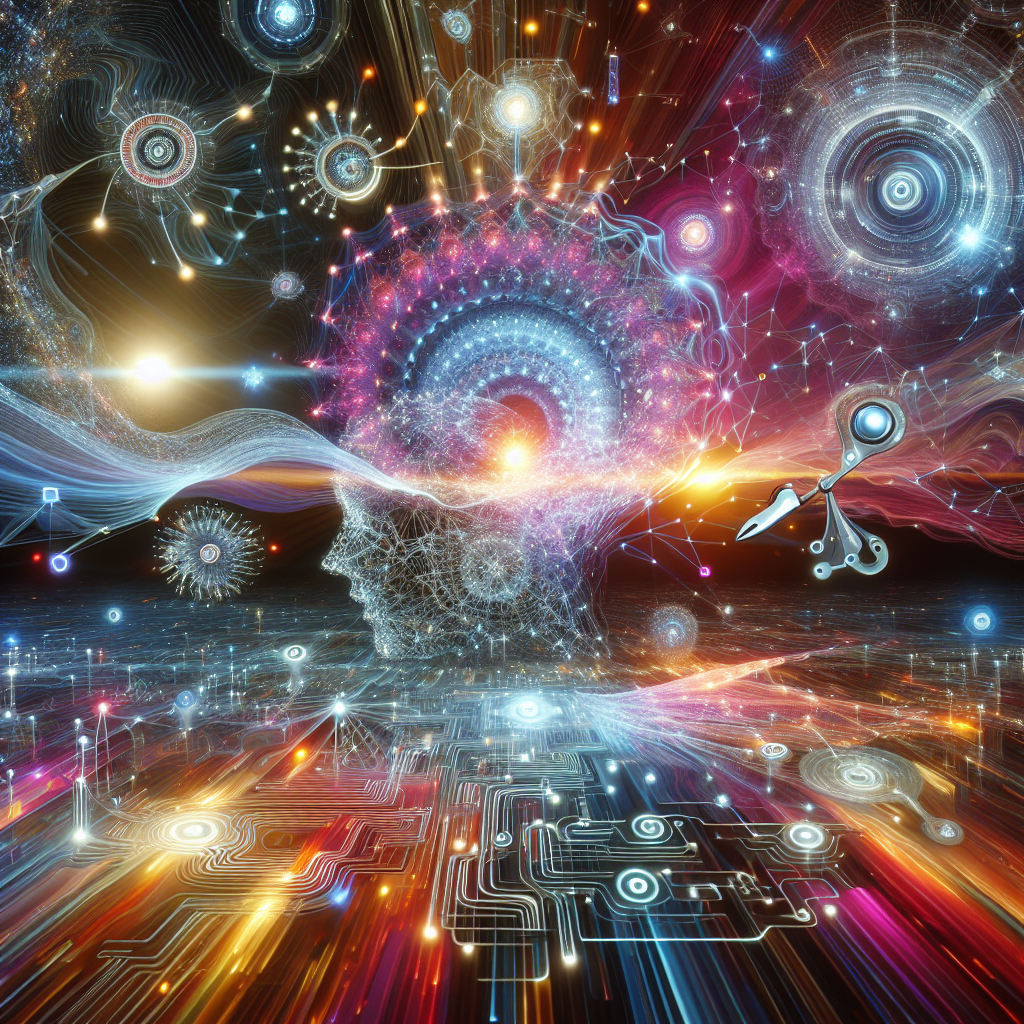Exploring the fascinating world of AI hallucinations: uncover the truth behind this digital phenomenon and how to prevent it.

Image courtesy of via DALL-E 3
Table of Contents
- Introduction to AI Hallucination
- Why Do AI Hallucinations Happen?
- Real-Life Examples of AI Hallucination
- How to Recognize AI Hallucinations
- How AI Developers Try to Fix Hallucinations
- The Future of AI and Hallucinations
- Why Understanding AI Hallucination Matters
- Summary
- Frequently Asked Questions (FAQs)
Introduction to AI Hallucination
Artificial Intelligence, often called AI, is a fascinating and powerful technology that is changing the way we interact with machines. But have you ever heard of AI hallucination? This digital phenomenon can sometimes make AI give answers or results that aren’t quite right. Let’s delve into what this means in simpler terms.
What is AI?
Imagine your friend Siri on your phone or Alexa in your home. They can talk to you, answer questions, and even help you with daily tasks. Well, these smart assistants use artificial intelligence to understand what you ask and respond to you. In simple words, AI helps computers think and act like humans in some ways.
Understanding Hallucination
Now, let’s talk about hallucination. Have you ever misheard something or thought you saw a shadow that wasn’t really there? Sometimes our brains can play tricks on us, making us believe things that aren’t true. This is similar to what happens with AI hallucination, where the computer might give wrong answers or information.
AI Hallucination Explained
So, when AI hallucinates, it means that the artificial intelligence system is giving responses that are not accurate or real. It’s like asking a calculator what 2 + 2 is, and it says 5! Just like we need to double-check our math, we also need to be cautious with the information we get from AI.
Why Do AI Hallucinations Happen?
When you ask a question to an AI like Siri or Alexa, you expect to get the right answer. But sometimes, AI can make mistakes and give you wrong information. This is what we call AI hallucination. Let’s dig deeper into why this happens.
Data Errors
AI learns from the data it is given. If the data has mistakes or is not enough, the AI might not give accurate answers. Just like how studying with wrong notes can lead to wrong answers on a test, AI needs the right data to give correct responses.
Misleading Information
AI can search the internet for information when you ask a question. But sometimes, it might find wrong or misleading information online and use it to answer your query. This can cause AI to spread false details and lead to hallucinations.
Real-Life Examples of AI Hallucination
AI hallucination isn’t just a concept in theory; it can actually happen in real-life scenarios. Let’s explore a couple of instances where AI has given incorrect results and caused confusion.

Image courtesy of www.nttdata.com via Google Images
Wrong Answers in Homework
Imagine working on your homework and turning to an AI-based tool for help, only to receive incorrect answers. This has actually happened to many students who rely on AI for assistance. Sometimes, these tools may not have the correct information or may misinterpret the questions, leading to inaccurate responses.
AI in Games
In the world of gaming, AI characters can sometimes act strangely or make decisions that seem unrealistic. This can be a form of AI hallucination, where the programmed algorithms don’t quite align with expected behaviors. Players may notice these discrepancies when AI opponents act in unpredictable ways or make odd choices during gameplay.
How to Recognize AI Hallucinations
One way to recognize AI hallucinations is by cross-checking the information it provides. This means verifying the answers or results from the AI with trusted sources. If the information seems too good to be true or doesn’t match what you know to be correct, it might be an AI hallucination. By double-checking the information, you can avoid falling for false data.
Understanding Limits
Another important way to recognize AI hallucinations is by understanding the limits of what AI can accurately provide. AI systems are powerful tools, but they are not infallible. They have boundaries to what they can know and understand. By knowing these limitations, you can better assess whether the information given by AI is trustworthy or not.
How AI Developers Try to Fix Hallucinations
One way AI developers try to fix hallucinations is by providing the AI with more and better-quality data. Just like how studying more helps us humans learn and understand things better, feeding AI systems with more accurate and diverse data helps them make more informed decisions. By enhancing the data available to AI, developers aim to reduce the chances of the AI giving incorrect answers or results.

Image courtesy of www.wherescape.com via Google Images
Algorithms Improvements
Another approach taken by tech experts is to make necessary changes to the AI’s programming. Think of algorithms as the set of instructions that guide AI on how to process information and respond. By fine-tuning these algorithms, developers can help the AI better understand and interpret the data it receives, leading to more accurate outcomes. These improvements in algorithms play a significant role in minimizing errors and enhancing the overall reliability of AI systems.
The Future of AI and Hallucinations
In the ever-evolving world of technology, the future holds exciting possibilities for artificial intelligence (AI) systems and their potential to reduce instances of AI hallucinations. As scientists and developers continue to push the boundaries of what AI can achieve, we can expect significant improvements in the accuracy and reliability of AI-generated information.
Upcoming Technologies
One of the key areas of focus for researchers is the development of new technologies that can enhance the performance of AI systems. With advancements in machine learning algorithms and data processing capabilities, AI systems will become better equipped to analyze information and provide more accurate results. Additionally, the integration of natural language processing and contextual understanding into AI models will enable them to interpret human queries more effectively, reducing the likelihood of hallucinations.
AI Becoming Smarter
Another promising direction in the field of AI is the quest to make AI systems smarter and more attuned to human behavior and needs. By incorporating elements of emotional intelligence and empathy into AI models, scientists hope to create AI systems that can better understand the nuances of human interaction and communication. This deep understanding of human behavior will allow AI to provide more personalized and accurate responses, minimizing the occurrence of hallucinations.
Why Understanding AI Hallucination Matters
AI has become an integral part of our daily lives, assisting us with tasks, answering our questions, and even playing games with us. However, it’s crucial to understand that AI, just like humans, can make mistakes. This is where the concept of AI hallucination comes into play.

Image courtesy of www.shaip.com via Google Images
Staying Informed
It’s essential for us, especially kids, to be aware of AI’s limitations and potential errors. By understanding that AI can sometimes provide incorrect answers or results, we can approach its responses with caution and verify information from reliable sources.
Making Better Choices
By knowing about AI hallucination, we can make better choices when using AI tools. Whether it’s for homework help, gaming, or daily tasks, being informed about AI’s occasional errors can help us make more accurate decisions and not rely solely on AI for critical information.
Summary
In this article, we explored the fascinating world of AI hallucination. We started by understanding what AI is, comparing it to familiar virtual assistants like Siri or Alexa. Then, we dived into the concept of hallucination, drawing parallels between human and AI experiences.
We learned that AI hallucination occurs when artificial intelligence systems provide answers or results that are incorrect or not real. This can happen due to errors in the data they are trained on, or from picking up misleading information from the internet.
Real-life examples, such as students receiving wrong answers from AI homework tools or strange behaviors in AI-powered games, helped us see how AI hallucinations can manifest in everyday situations. By recognizing these instances, we can begin to mitigate their impact.
Understanding how to spot AI hallucinations is crucial. We discussed the importance of cross-checking information with reliable sources and recognizing the limitations of AI systems. By being vigilant, we can reduce the influence of AI errors in our lives.
To address AI hallucinations, developers are constantly working on improving data quality and enhancing algorithms. These efforts aim to make AI systems more accurate and reliable, contributing to a more trustworthy digital landscape.
Looking towards the future, we explored upcoming technologies and advancements that hold the promise of smarter AI systems. By continuing to innovate and refine AI capabilities, we can expect a future where artificial intelligence better understands human needs.
It is essential to grasp the significance of understanding AI hallucination. By staying informed about AI’s limitations and being cautious with its outputs, we can make better decisions and engage with technology responsibly.
Final Thoughts
As we wrap up our exploration of AI hallucination, it’s crucial to approach AI with curiosity and awareness. Embracing the potential of artificial intelligence while being informed about its pitfalls allows us to navigate the digital world with confidence and wisdom.
Want to turn these SEO insights into real results? Seorocket is an all-in-one AI SEO solution that uses the power of AI to analyze your competition and craft high-ranking content.
Seorocket offers a suite of powerful tools, including a Keyword Researcher to find the most profitable keywords, an AI Writer to generate unique and Google-friendly content, and an Automatic Publisher to schedule and publish your content directly to your website. Plus, you’ll get real-time performance tracking so you can see exactly what’s working and make adjustments as needed.
Stop just reading about SEO – take action with Seorocket and skyrocket your search rankings today. Sign up for a free trial and see the difference Seorocket can make for your website!
Frequently Asked Questions (FAQs)
Can all AIs hallucinate?
Yes, all forms of AI have the potential to hallucinate, which means they can give incorrect or false information. Just like humans can make mistakes, AI systems can also provide inaccurate answers, especially when they are not properly trained or when the data they receive is flawed.
Is AI hallucination dangerous?
While AI hallucination may not always pose direct physical risks, it can lead to misinformation or incorrect results, which can have negative consequences. For instance, relying on AI for critical decisions like medical diagnoses or financial advice based on erroneous information can be harmful. To mitigate the risks associated with AI hallucination, it’s essential to cross-check the information provided by AI with reliable sources and be aware of the limitations of AI systems.







